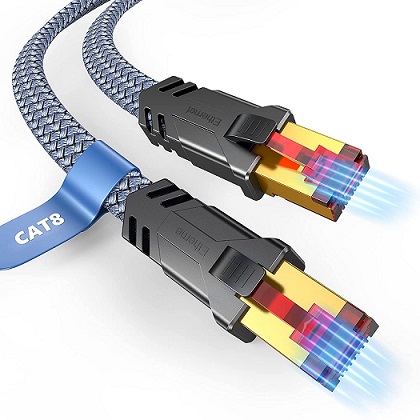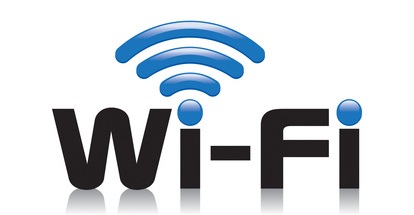In this guide, let us explore some essentials of Ethernet and Wi-Fi. We will weigh-in the pros and cons of each type. After that, we will see if we can connect to both Wi-Fi and Ethernet and use it simultaneously.
A Brief Note on Ethernet and Wi-Fi
1. Ethernet
The wired connection you use with your PC or Laptop is Ethernet. You form a LAN (Local Area Network) with all the ethernet cables and devices. There are several types of Ethernet Cables such as CAT5/5E, CAT6/6A, CAT7/8, etc. But all of them have four pairs of twisted-pair wires with RJ-45 termination. Hence, we sometimes call the ethernet port or connector RJ-45. As ethernet is a hardwire connection to the router or modem, there are some advantages. You can get the maximum possible internet speeds using ethernet. Speaking of speeds, if you have the right adapter and cable, you can get up to 10Gbps of transfer speeds. There will be no issue of signal drop or something else. The connection is always stable with ethernet and there is no latency. But the drawbacks are you need to wire your home or office to get ethernet connectivity in every room. Also, with ethernet, you lose mobility.
2. Wi-Fi
Wireless LAN (WLAN) or simply Wi-Fi is a wireless way to connect to the router or access point. There is no need for a physical connection between the device (smartphone or laptop) and the Wi-Fi router. You can access the internet wirelessly from anywhere within the range. Mobile, tablets, and laptops are the main devices that make use of Wi-Fi. Nowadays, it is one of the popular ways to connect to the internet. If you have multiple such devices, then installing a good Wi-Fi Router will ensure that all of them can have wireless internet connectivity. Even if you have a large house or office, you can create a mesh network using multiple Wi-Fi routers or Wi-Fi Extenders. While mobility and whole-house internet connectivity are the benefits of Wi-Fi, there are some downsides as well. The first thing is the speed of the internet off of a Wi-Fi Network is less than what you can get from an ethernet connection. Also, the range is an issue. If you move slightly farther from the router, you will lose the signal and thereby have no internet connectivity. Gamers generally don’t use Wi-Fi for internet connectivity due to latency concerns.
Can You Use Wi-Fi and Ethernet at the Same Time?
Almost all modern laptops come with both Wi-Fi and ethernet connectivity. Even if some don’t have an ethernet port, you can get a good quality Ethernet to USB adapter. Irrespective of the availability of the port, a common question is can you use Wi-Fi and Ethernet at the same time? Let us explore more on this topic. Technically, you can connect to both Wi-Fi and Ethernet at the same time. But the problem is with modern operating systems and networking hardware. For example, if you have a Windows Laptop with both Wi-Fi and Ethernet connections up and running. What Windows does is it prioritizes one connection over the other. This is usually Ethernet over Wi-Fi. So, even if you connect both Wi-Fi and Ethernet at the same time, the device uses only one connection for data transfer. Does this mean we can’t use both Ethernet and Wi-Fi simultaneously? We can use both of them at the same time but you need to change some settings. Find out more about these settings in the next section. In the meantime, let us try to understand why we need to have both Wi-Fi and ethernet at the same time.
Need for Connecting Wi-Fi and Ethernet at the Same Time
There are a couple of scenarios we can think of that helps us understand this unique situation. Assume you have a local server in your home with all your personal files. These can be movies, music, images, videos, or documents. You don’t want this server on the internet yet you want to access the files from your laptop. In this case, you can use your Wi-Fi to connect to the internet and ethernet to connect to the server. Another useful approach is if you have two different internet connections. Connect one network to Wi-Fi and the other to Ethernet. This acts as a redundant solution for critical systems. If one network fails, you will still have internet through the other connection.
How to Use Ethernet and Wi-Fi at the Same Time?
Now comes the important part. How to connect the laptop to both Wi-Fi and Ethernet at the same time? As we mentioned earlier, Windows OS prioritizes one connection over the other. So, the solution is to disable this priority setting. Here is a simple guide for the same.
Open Control Panel and go to Network and Sharing Center. Click on the ‘Change adapter settings’ option on the top left section. Depending on your system, you will have multiple adapters. We need to modify the settings for the Ethernet adapter. Identify the correct ethernet adapter, right-click on it and select ‘Properties’. You can see the name of the ethernet adapter. Just below it, there will be a ‘Configure’ button. Click on this button. A new properties window opens. Go to the ‘Advanced’ tab. On the left, there will be a ‘Property’ section with several options. Look for ‘Priority & VLAN’. Once you select this property, you get appropriate ‘value’ options on the right. Select ‘Priority & VLAN Disabled’. Click on OK. This will reset your ethernet connection with priority disabled. You are ready to use both Ethernet and Wi-Fi at the same time.
Will This Double My Internet Speed?
Now that we have seen how to connect to both Wi-Fi and ethernet, the next important question is: will this procedure double my internet speed? Sadly, this won’t happen. First of all, your ISP will set the internet speed limit. For instance, if you have a plan of 300Mbps, then this is the maximum internet speed you can expect from your router. So, even if you connect to both Wi-Fi and ethernet at the same time, it still has to go through the same router. The router, your Wi-Fi and Ethernet adapters are intelligent devices. They communicate with each other and let only one device to transmit the data. There is a problem with this type of setup. As your laptop or PC has both Wi-Fi and ethernet connections, there is a chance of packet loss. Your laptop cannot resolve the data and asks the router to re-transmit. This essentially slows down the connection.
Conclusion
Wi-Fi is the most popular way to connect to the internet. Laptops, PCs, TVs, Smartphones, Tablets, etc. use wireless connectivity for internet access. Devices like laptops and PCs also have ethernet connectivity options. Gamers and people who need speed and reliability generally prefer ethernet over Wi-Fi. If you have both ethernet and Wi-Fi on a device, then can you use Wi-Fi and Ethernet at the same time? This is a very popular question. In this guide, we saw the basics of Ethernet and Wi-Fi. After that, we understood the problem with modern hardware and OS regarding why you cannot connect to both connections at the same time. Finally, we saw a simple change of setting to allow the computer to use both Wi-Fi and Ethernet at the same time. Comment * Name * Email * Website
Δ







![]()